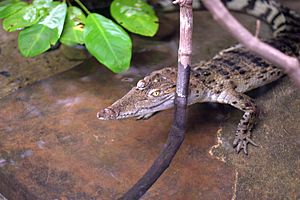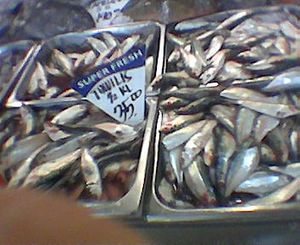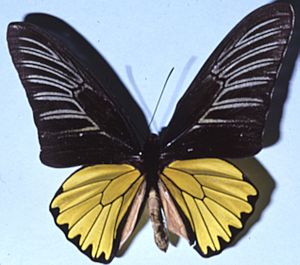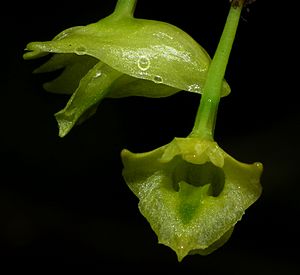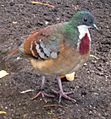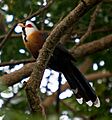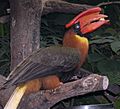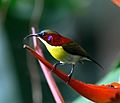Wildlife of the Philippines facts for kids
The Philippines is an amazing country, home to a huge variety of plants and animals. Many of these species are endemic, meaning they are found nowhere else in the world! The waters around the Philippines are also incredibly rich, with some of the highest levels of ocean life diversity on Earth. Because of this, the Philippines is known as one of the seventeen "megadiverse countries" and a "global biodiversity hotspot." This means it has a lot of unique life, but also that many species are in danger. In 2000, 418 of the country's over 52,000 species were listed as threatened.
Scientists are still discovering new species in the Philippines all the time. In the last ten years alone, sixteen new types of mammals were found! This high rate of discovery means the number of unique species found only in the Philippines continues to grow.
Contents
Birds of the Philippines

The Philippines is home to 612 different kinds of birds. A huge number, 194 of them, are found only in the Philippines! Some birds have been brought in by humans, and 52 are rare visitors. Sadly, 67 bird species are globally threatened.
One of the most famous is the Philippine eagle, which is the national bird and is critically endangered. Another special bird is the rufous hornbill. The Philippines also has the blue-winged racket-tail, the most endangered parrot in Southeast Asia, found only on Tawi-Tawi. The Calayan rail, the world's most endangered rail species, lives on a small island in the Babuyan Group.
The Zoological Society of London says the Philippines has the most unique bird species in the world. Six of the world's 50 most "evolutionary distinct and globally endangered" (EDGE) species live here. These include the Philippine eagle (ranked 15th), the spoon-billed sandpiper (19th), the black-hooded coucal (22nd), the Sulu hornbill (41st), the Cebu brown-dove (46th), and the rufous-headed hornbill (50th).
Amphibians and Reptiles
The Philippines has over 111 types of amphibians and 270 types of reptiles. A large number of these are endemic: 80% of amphibians and 70% of reptiles are found only here. Out of 114 snake species, only about 14 are venomous. Scientists believe many more species are yet to be discovered. Sadly, some might have disappeared before we even knew about them. The Philippines also has 50-60 unique Platymantis frog species, making it a very diverse group.
The freshwater Philippine crocodile is critically endangered. It is considered the most threatened crocodile in the world. In 1982, there were only about 500-1,000 in the wild. By 1995, only about 100 remained. Recently, a new group of these crocodiles was found in the Sierra Madre mountains of Luzon, which gives new hope! Projects like the Crocodile Rehabilitation, Observance and Conservation (CROC) Project are working hard to save them.
Other unique and threatened reptiles include Gray's monitor and the Philippine forest turtle. Two new types of monitor lizards have been found that mostly eat fruit: the Panay monitor lizard and the Northern Sierra Madre forest monitor. These are very rare, as only three monitor lizard species in the world specialize in eating fruit.
Freshwater Fish
The Philippines has about 330 kinds of freshwater fish. This includes nine unique groups and over 65 unique species. Many of these are found only in a single lake. For example, Sardinella tawilis is a type of freshwater sardine found only in Taal Lake.
Sadly, Lake Lanao in Mindanao has seen a terrible loss of its unique fish. Almost all of the fish species found only in that lake are now extinct. This happened mainly because of the introduction of tilapia, a fish brought in for fishing. Other non-native species were also introduced to the lake, causing problems for the native fish.
Insects and Other Invertebrates
About 70% of the Philippines' nearly 21,000 recorded insect species are found only in the country. About one-third of the 915 butterfly species here are endemic. More than 110 of the over 130 types of tiger beetles are also unique to the Philippines. The Magellan birdwing, one of the largest butterflies in the world, lives here. The Atlas moth, the largest moth, can also be found in the Philippines.
The Philippines also has many different types of crustaceans. Over 50 species of freshwater crabs are known from the Philippines, and all of them are endemic.
Flora: Plants of the Philippines
At least one-third of the more than 9,250 types of vascular plants native to the Philippines are endemic. While no entire plant families are found only here, many species within families are unique. For example, the families of gingers, begonias, orchids, pandans, and palms have many endemic species. Two-thirds of the 150 palm species in the country are found nowhere else. Also, 700 of the 1,000 orchid species in the Philippines are unique to its wildlife.
The lowland and hill rainforests of the Philippines used to be filled with huge trees called dipterocarps. These massive trees were common up to 1,000 meters above sea level. Other important trees include giant figs, which provide food for fruit bats, parrots, and monkeys. The Pterocarpus indicus tree is also valued for its wood, like the dipterocarps.
A few species of the unique Rafflesia flower are found in the Philippines, including Rafflesia philippensis.
Images for kids
-
Philippine duck, Anas luzonica
-
Mindanao bleeding-heart, Gallicolumba criniger
-
Green imperial-pigeon, Ducula aenea
-
Philippine cockatoo, Cacatua haematuropygia, the only species of cockatoo found in the Philippines
-
Palawan hornbill, endemic to the Philippines, usually travels in pairs or in small noisy groups
-
Rufous hornbill, Buceros hydrocorax
-
Dendrobium anosmum. Some specimens from the Philippines are unscented. However, most of these orchids are fragrant, giving them the combined Tagalog name Sanggumay for their strong scent.


